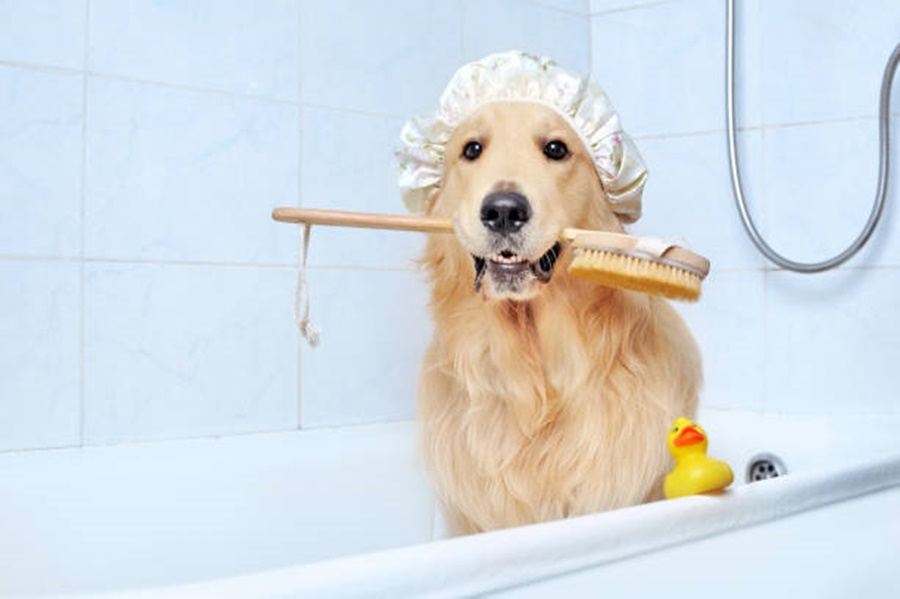Keeping our furry companions clean is essential for their health, hygiene, and overall well-being. But what if you don’t have a bathtub? Whether you live in a small apartment, are traveling, or simply lack access to a tub, washing a dog without a bathtub is not only possible it can be just as effective, stress-free, and even enjoyable. Below is the most comprehensive, step-by-step guide to ensure your dog stays clean and happy without a traditional tub setup.
Best Alternatives to a Bathtub for Washing Your Dog
When a bathtub isn’t an option, various alternatives can be used to clean your dog efficiently:
1. Use a Walk-In Shower or Stand-Up Shower
A walk-in shower with a handheld nozzle is an excellent substitute. It provides drainage, space, and easy cleanup.
Pro Tip: Place a non-slip mat on the floor to prevent accidents.
Use lukewarm water and adjust the pressure to be gentle on your dog’s skin.
2. Outdoor Hose Bath (Weather Permitting)
If it’s warm outside, a garden hose can be your best friend. Make sure the water is not too cold or too forceful.
Choose a shady area to prevent overheating.
Use a portable dog washing station or a kiddie pool for better containment.
Rinse thoroughly to avoid leaving any shampoo residue on your dog’s coat.
3. Kitchen or Utility Sink for Small Breeds
For small dogs, a deep kitchen sink or utility sink is a practical solution.
Line the bottom with a towel to prevent slipping.
Avoid using the kitchen sink if your dog sheds heavily hygiene is key.
4. Dog Washing Stations or Self-Serve Dog Wash Locations
Many pet stores and grooming salons offer DIY dog wash stations with professional-grade equipment.
These facilities often provide shampoo, aprons, high-powered dryers, and elevated tubs.
A great choice for those who prefer not to clean up the mess at home.
What You’ll Need Before You Start
Gather all supplies before bringing your dog to the wash area to ensure a smooth process:
Dog shampoo (never use human shampoo)
Brush or comb (pre-bath brushing reduces matting)
Non-slip mat or towel
Clean towels
Cup or sprayer for rinsing
Treats for positive reinforcement
Dryer (air-dry or dog-safe blow dryer)
Step-by-Step Guide to Wash Your Dog Without a Bathtub
Step 1: Brush Your Dog Before the Bath
Always start by brushing your dog’s coat to remove tangles, mats, and loose fur. This makes washing more effective and prevents further knotting when the fur gets wet.
Step 2: Choose and Prepare the Wash Area
Set up your wash station in advance. Whether it’s a shower, sink, or outdoor space, ensure:
The surface is secure and non-slippery
You have everything within reach
The water temperature is lukewarm
Step 3: Wet the Dog Thoroughly
Use a sprayer or a large cup to wet your dog from neck to tail, avoiding eyes and ears. Wetting the coat fully is critical for an even shampoo lather.
Step 4: Apply Dog-Specific Shampoo
Use a mild, hypoallergenic dog shampoo suited for your dog’s coat and skin condition. Lather it gently, massaging into the fur and skin.
Pay special attention to paws, underarms, belly, and tail area.
Avoid sensitive areas like the eyes, ears, and inside the nose.
Step 5: Rinse Thoroughly
Rinse completely until no soap suds remain. Leftover shampoo can irritate the skin, so take your time here.
Use a handheld sprayer or a cup to pour clean water over the coat.
Keep rinsing until the water runs completely clear.
Step 6: Dry Your Dog Properly
Use a clean, dry towel to absorb as much water as possible. For longer-haired dogs or colder climates, consider using a dog blow dryer on a cool or low heat setting.
Avoid using regular human hair dryers unless they have a low-heat option.
If outside, ensure your dog stays warm while drying.
How Often Should You Wash Your Dog Without a Bathtub?
The frequency depends on your dog’s breed, lifestyle, and skin condition:
Indoor dogs can be washed every 4–6 weeks.
Active outdoor dogs may need a bath every 2–4 weeks.
Dogs with skin conditions should follow vet-recommended bathing schedules.
Overwashing can strip natural oils, so always prioritize skin health and consult your vet if unsure.
Tips to Keep Your Dog Calm During Bath Time
Some dogs can be anxious about getting wet, especially in unfamiliar setups. Here’s how to make bath time easier:
Use treats and praise throughout the process.
Talk in a calm, reassuring voice.
Use slow, gentle motions when applying water or shampoo.
Make sure your dog is not startled by sudden noises like running water or blow dryers.
What If Your Dog Hates Water? Waterless Options
If your dog strongly resists traditional bathing, consider waterless alternatives:
1. Dry Shampoo for Dogs
Available as sprays, foams, or powders, these clean and deodorize without water.
Apply directly to the coat and brush thoroughly.
Ideal for quick touch-ups between regular baths.
2. Pet Wipes
Specially formulated dog grooming wipes help clean dirt and dander without the mess.
Perfect for paws, face, and private areas.
Choose unscented, hypoallergenic varieties for sensitive skin.
Maintaining a Clean Dog Between Baths
To reduce the frequency of full baths, keep up with regular grooming and hygiene:
Brush daily or weekly, depending on coat type.
Clean ears and trim nails regularly.
Wipe paws after walks.
Use deodorizing sprays as needed.
This helps your dog stay cleaner longer and avoids unnecessary bathing stress.
Conclusion
You don’t need a fancy bathtub to keep your dog clean and healthy. With a little preparation, creativity, and the right tools, washing your dog without a tub becomes a simple part of your routine. Whether using a shower, sink, or garden hose, the key is to be gentle, thorough, and consistent.

